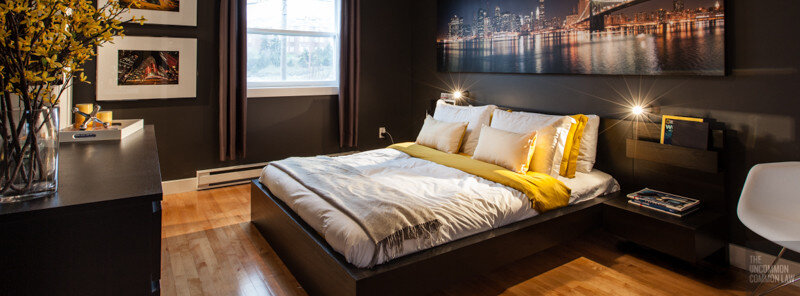Lighting Part 2: Lighting Technology
Welcome to part 2 of our multipart series! Previously, you learned about the physical characteristics of a light and how to make sense of all those numbers on the box. Today we will go over the various lighting technologies available to the consumer.
Bedside low voltage halogen lights in our master bedroom provide a warm white light.
Incandescent lighting
Incandescent lighting refers to the traditional technology of electricity flowing through a (tungsten) filament which acts as a resistor to create light (and heat). This form of lighting is fairly inefficient, with the majority of the energy consumed being released as heat.
Halogen lighting falls under this category and is marginally more efficient than traditional tungsten bulbs with a longer rated life. The wide availability, easy dimmability, and high CRI of incandescent lighting is offset by its poor efficiency and shorter lifespan when compared to other technologies. Note that incandescent lighting is being phased out, although it looks like halogens are ok in Canada for the time being.
Fluorescent in wall strip lights shown in our basement stairwell produce a flattering soft light. Fluorescent fixtures, however, aren't universally dimmable, are difficult to perfectly match to the colour temperature of incandescents/halogens, and generally have a low CRI.
Fluorescent lighting
Fluorescent lights function by transmitting current through a tube filled with inert gas/small amount of mercury, which creates ultraviolet light. This light excites the phosphor coating on the inside of the tube, which releases visible light through fluorescence.
The lights come in all shapes and sizes ranging from prototypical fluorescent tubes (usually seen in commercial settings) to spiral compact fluorescent bulbs (CFLs) made to replace traditional Edison screw incandescent bulbs. While more expensive than traditional incandescent lighting, fluorescent lighting is more efficient and lasts longer. Most modern fluorescent fixtures have electronically controlled ballasts (built in to CFLs) that have overcome the buzzing and flickering problems of older generation fixtures. The problem, however, is that the CRI is generally poor (less than 80) and many fluorescent fixtures have issues with dimmability (requires special ballast, can't dim lower than 5% or 10%). Although many different color temperatures are available to match the lighting in your home, I do notice that many have an annoying green or magenta cast. It’s for these reasons that I personally avoid CFLs lights for any main lighting.
Light Emitting Diodes (LEDs)
Light emitting diodes create light by passing current through a semiconductor which emits light through a process called electroluminescence. Some LED bulbs will have a mixture of phosphor coatings integrated to improve the CRI of the light emitted.
Of the various technologies, LEDs have the highest efficiency. They are made in a wide array of colors/color temperatures, sizes, and CRIs. They are, however, significantly more expensive than fluorescent and incandescent lights. Common LED products are strip lights, which come as rigid bars and flexible strips in a multitude of different colors, and white LED “bulbs” designed to retrofit into standard sockets (Edison, GU10, MR16, etc).
A low voltage power supply/driver is needed to power an LED light, which may be external to the light or be built into the light/fixture. If dimmability is required, one needs a driver that can perform pulse width modulation (PWM) to rapidly cycle the LED, since they are either on or off. Similar to fluorescent lights, many dimmable drivers won't dim lower than 5%, making a smooth ramp from off impossible. The multitude of options can make LED lighting confusing. Just know that LEDs can be purchased to fit into most standard light bulb bases (with drivers already built in), or can be purchased separately (as part of a light fixture or strip light) which requires installation of a separate driver.
Eventually LEDs will take over in home lighting, but high CRI models are still quite costly and still need to be integrated into common bases (MR16, GU10). I'm still waiting for the perfect LED light: GU10 base to work with our existing recessed halogen fixtures, TRIAC dimmable to work with our Insteon dimmers, high CRI, cost effective, plus or minus integrated colour changeability! Maybe a pipe dream, but Philips seems to be the closest.
LEDs come in many different forms to cover standard as well as specialty lighting applications. Shown here are colour changeable RGB LEDs in our living room which provide optional mood lighting.
Here is a summary table of the various technologies:
Stay tuned for part 3 of our series which will cover the common types of lighting fixtures you may come across!




